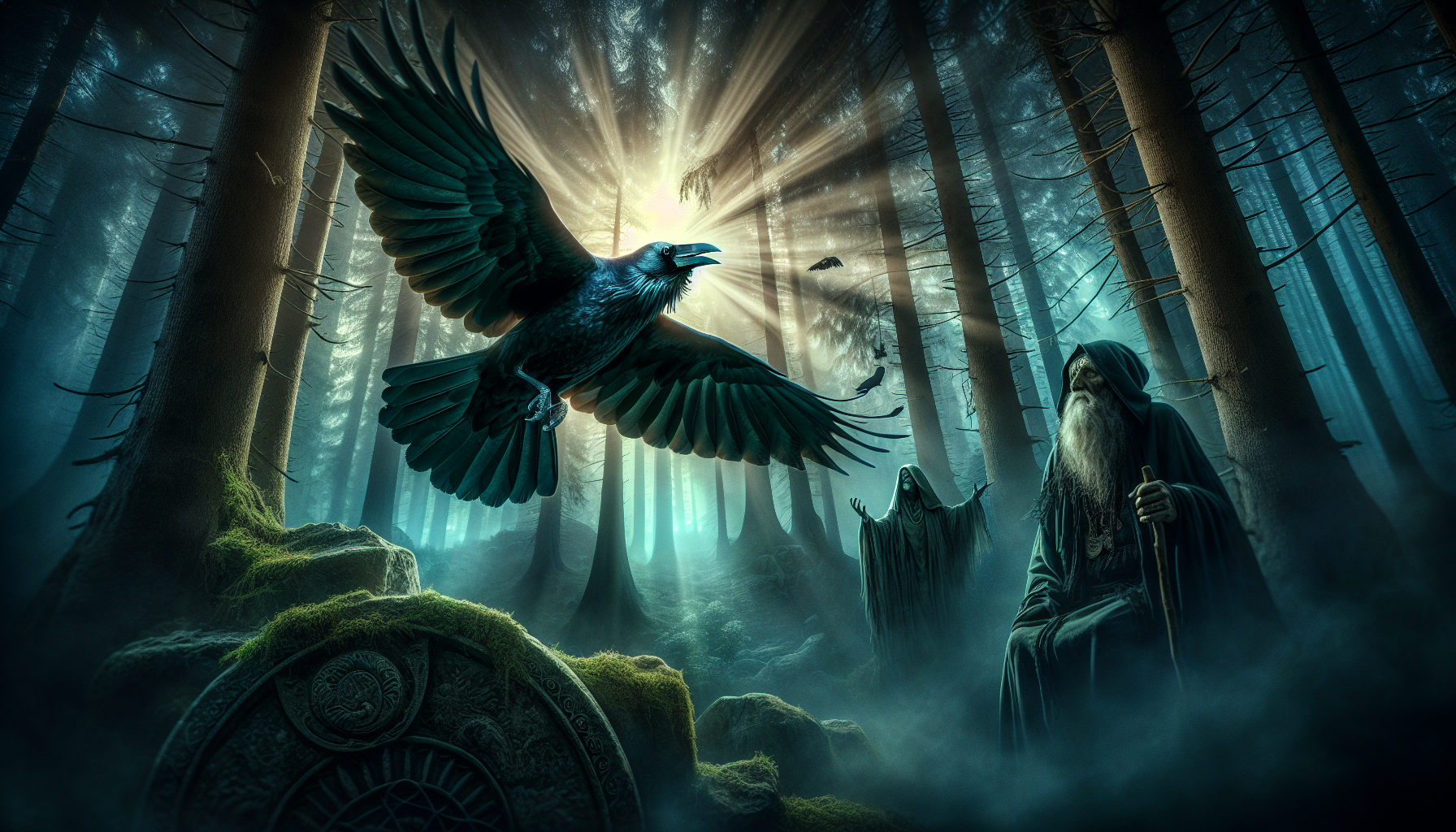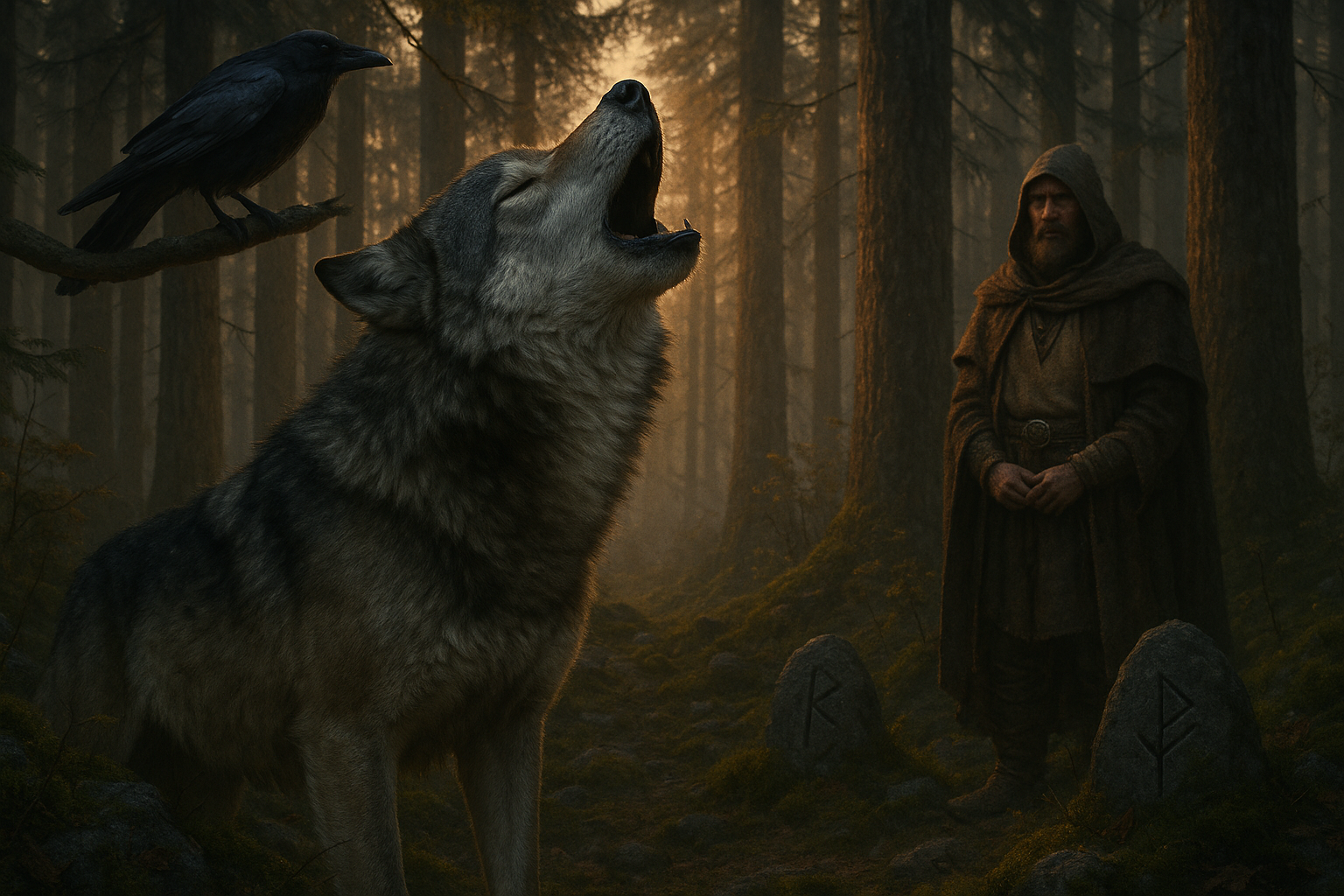In the tapestry of nature, few creatures have captured human imagination quite like the raven. With their glossy black feathers and piercing eyes, these enigmatic birds have been the subject of myth, folklore, and spiritual exploration across cultures and centuries. Their mysterious aura and undeniable intelligence beckon us to delve deeper into their world, sparking curiosity and awe. But ravens are more than just symbols of the unknown; they are messengers of wisdom and guidance, bridging the gap between the natural and the supernatural. As you embark on this journey through the mystical realm of ravens, prepare to unlock secrets that could change the way you perceive these remarkable creatures—and perhaps even alter your own path in life. 🌌
The allure of ravens extends beyond their physical presence, reaching into the very heart of cultural and spiritual traditions. From Norse mythology, where Odin’s ravens, Huginn and Muninn, symbolize thought and memory, to Native American lore that views them as creators and transformers, ravens have been revered as guides and protectors. These stories offer more than mere entertainment; they hold keys to understanding how ravens can serve as conduits for knowledge and insight. In our modern world, where the clamor of daily life often drowns out the whispers of intuition, these birds remind us to listen, observe, and learn from the world around us. As you navigate through this article, we will explore the rich tapestry of raven mythology, their roles in various cultural narratives, and the lessons they impart.
But the mystique of ravens isn’t confined to ancient tales. Modern science has uncovered fascinating aspects of raven behavior that affirm their status as one of the most intelligent bird species. From problem-solving abilities to complex social dynamics, ravens exhibit traits that continue to astonish researchers and bird enthusiasts alike. In this exploration, we will delve into recent scientific findings that shed light on the cognitive prowess of ravens, offering a new dimension to their role as messengers of wisdom. Whether through the lens of science or spirituality, ravens beckon us to embrace the unknown and seek wisdom in unexpected places. By the end of this article, you will not only have a deeper appreciation for these majestic birds but also be inspired to heed their call for introspection and transformation. 🖤
The Enigmatic Nature of Ravens
Ravens have fascinated human beings for centuries, their dark plumage and mysterious aura often linked with mystical powers and supernatural realms. These birds, belonging to the genus Corvus, are not just ordinary creatures; they are deeply embedded in various cultural mythologies and spiritual beliefs. Ravens are known for their intelligence, problem-solving skills, and ability to mimic human speech, which sets them apart from other avian species.
In many cultures, ravens are seen as messengers between the earthly realm and the spiritual world. Their black feathers and piercing eyes often symbolize wisdom, transformation, and the unknown. But what is it about ravens that inspires such awe and reverence? Is it their uncanny ability to adapt to different environments, or perhaps their complex social structures and communication skills?
For those who delve deeper into the mystical aspects of ravens, these birds offer a wealth of symbolism and insights. In Norse mythology, the god Odin was often depicted with two ravens, Huginn and Muninn, representing thought and memory. Similarly, in Native American cultures, ravens are considered creators and are thought to bring light into the world. These narratives underscore the universal allure of ravens and their perceived role as guides and carriers of wisdom.
Raven Symbolism Across Cultures
The symbolism associated with ravens varies across different cultures, yet a common thread ties them to themes of transformation and enlightenment. For instance, in Celtic mythology, ravens are associated with the Morrigan, a goddess of war and fate, signifying the connection between life and death. This duality highlights the raven’s role as a bridge between the physical and spiritual worlds.
In Eastern traditions, ravens are often viewed as harbingers of change. In Chinese culture, the raven is a solar symbol, representing the sun’s transformative power. Meanwhile, in Japanese folklore, ravens are seen as divine messengers, linking the human world with the gods. These interpretations emphasize the raven’s role in facilitating transitions and guiding individuals through life’s challenges.
To further explore these rich cultural narratives, watch the video below, which delves into the symbolic meanings of ravens across the globe.
Watch: “The Symbolic Raven” on Mythical Channel
Ravens as Messengers of Wisdom
Ravens are not just symbols; they are also practical messengers of wisdom. Their advanced cognitive abilities and adaptability make them excellent problem solvers, capable of understanding complex tasks and using tools to achieve their goals. These skills highlight the raven’s intelligence, which is comparable to that of primates.
Research has shown that ravens possess a remarkable memory and can plan for future events, a trait once thought to be exclusive to humans. They can remember human faces, hold grudges, and even communicate with each other about potential threats. This intelligence is not only fascinating but also indicative of the raven’s role as a guardian and guide.
For those seeking personal growth or transformation, ravens offer a source of inspiration. Their ability to navigate and thrive in various environments symbolizes resilience and adaptability. By observing ravens, individuals can learn to embrace change and overcome obstacles, drawing on the bird’s wisdom to guide them through life’s uncertainties.
Raven Communication and Social Structures
Ravens are highly social creatures, often forming complex social bonds and hierarchies. Their communication skills are sophisticated, involving a range of vocalizations, gestures, and even facial expressions. This complexity allows ravens to convey information, warn each other of dangers, and collaborate on tasks.
Studies have shown that ravens can recognize themselves in mirrors, a sign of self-awareness, and can engage in tactical deception to outsmart their peers. This level of intelligence and social awareness is rare among birds, further solidifying the raven’s status as a creature of mystery and wisdom.
Explore the table below to see a comparison of the cognitive abilities of ravens with other highly intelligent animals:
| Animal | Notable Cognitive Ability | Example Behavior |
|---|---|---|
| Raven | Tool Use and Planning | Using sticks to extract food |
| Chimpanzee | Social Learning | Imitating other chimpanzees |
| Dolphin | Complex Communication | Using vocalizations for social interaction |
| Elephant | Empathy and Mourning | Showing signs of grief for deceased companions |
Ravens in Myth and Reality
While myths and legends offer a fantastical perspective on ravens, scientific research provides a grounded understanding of these birds. Ravens’ impressive intelligence and adaptability are not just the stuff of legend; they are well-documented phenomena that highlight the bird’s extraordinary capabilities.
For example, ravens have been observed using sophisticated hunting techniques, such as creating diversions to distract predators while they raid nests. Their problem-solving skills are on par with those of great apes, making them one of the most intelligent bird species on the planet. This blend of myth and reality adds depth to our understanding of ravens and their role as symbols of wisdom and transformation.
Moreover, ravens’ ability to thrive in diverse habitats—from deserts to urban environments—underscores their resilience and adaptability. These traits are not only vital for their survival but also serve as a metaphor for human resilience in the face of adversity. By studying ravens, we can gain insights into how to navigate challenges and embrace change.
Human Connections with Ravens
Throughout history, humans have formed unique bonds with ravens, often relying on them for guidance and inspiration. This connection is evident in various cultural practices and spiritual beliefs, where ravens are revered as protectors and guides.
In some indigenous cultures, shamans use ravens as totems, believing that these birds possess the ability to communicate with the spirit world. This belief in the raven’s mystical powers highlights the bird’s role as a mediator between the earthly and spiritual realms.
For those interested in exploring the spiritual significance of ravens, the video below provides an in-depth look at how these birds are perceived in different spiritual traditions:
Watch: “Ravens in Spirituality” on Spiritual Insights Channel
Unlocking the Mystical Power of Ravens
Understanding the mystical power of ravens requires a blend of scientific inquiry and spiritual exploration. These birds are more than just symbols; they are living embodiments of wisdom, transformation, and resilience. By studying their behavior and cultural significance, we can unlock new insights into our own lives and the world around us.
Ravens teach us the value of adaptability, problem-solving, and embracing change. Their intelligence and social awareness offer valuable lessons on how to navigate the complexities of life. Whether through myth or reality, ravens continue to inspire and guide us, serving as messengers of wisdom in a world full of uncertainty.
In summary, ravens hold a unique place in both mythology and science, bridging the gap between the mystical and the tangible. Their enduring presence in our collective consciousness is a testament to their power as symbols of wisdom and transformation.

Conclusion
In conclusion, the exploration of the mystical power of ravens unveils a profound tapestry interwoven with threads of mythology, psychology, and environmental significance. Throughout this article, we have journeyed through various cultural narratives that elevate the raven to the status of a symbol of wisdom and transformation. From Norse mythology, where Odin’s ravens, Huginn and Muninn, traverse the world to bring back vital knowledge, to Native American traditions that portray the raven as a creator and trickster, these birds have inspired awe and curiosity across civilizations.
A significant portion of our discussion focused on the cognitive abilities of ravens, which are nothing short of remarkable. Their problem-solving skills, social dynamics, and ability to use tools showcase a level of intelligence that invites us to reconsider our understanding of animal cognition. These characteristics not only underline the raven’s role as a messenger of wisdom but also prompt us to reflect on our own relationships with the natural world. The birds’ interactions with their environment remind us of the delicate balance in ecosystems and the importance of every creature within them.
The psychological aspects of our connection with ravens further highlight their symbolic resonance. Ravens tap into the archetypal realm of the human psyche, often representing the shadow or the unknown. Engaging with these enigmatic birds can lead to deeper introspection and personal growth, as they challenge us to confront our fears and embrace transformation. By acknowledging the raven’s place in our collective unconscious, we gain insights into our own nature and the transformative power of facing the unknown.
Moreover, the ecological role of ravens as scavengers underscores their importance in maintaining the health of ecosystems. Their presence is a reminder of the intricate web of life and the necessity of biodiversity. By appreciating ravens not just for their mystical associations but also for their real-world contributions, we are encouraged to adopt a more holistic view of nature conservation.
In reinforcing the significance of ravens, we also acknowledge the broader implications for cultural and environmental preservation. Protecting these birds and their habitats is essential for maintaining the cultural stories and ecological functions they embody. As such, ravens serve as a bridge between the mystical and the tangible, urging us to preserve the legacies of both our natural and cultural heritage.
We invite you, dear reader, to reflect on the myriad ways ravens enrich our lives. Whether through the lens of mythology, psychology, or ecology, these birds challenge us to expand our understanding of the world. We encourage you to delve deeper into the lore and science surrounding ravens, share your insights with others, and consider how these enigmatic birds might inspire transformation in your own life.
If you feel moved by the stories and insights shared here, please comment below with your thoughts or personal experiences related to ravens. Sharing this article with friends and on social media can help spread awareness of the importance of these fascinating creatures. Let us embrace the wisdom of the raven and apply its lessons to create a more connected and mindful world. 🌍🖤
For further reading on ravens and their cultural significance, consider exploring resources such as the Cornell Lab of Ornithology’s comprehensive bird guide here and engaging with scientific discussions on animal cognition here.
By uniting the wisdom of ancient stories with modern scientific understanding, we can truly appreciate the raven’s role as a timeless messenger of guidance and transformation.
Toni Santos is a sound storyteller and folklore researcher whose creative path bridges the mystical and the biological through the lens of bioacoustic folklore. With an ear attuned to the voices of nature, Toni explores how ancient cultures interpreted birdsong, forest echoes, and animal calls—not as noise, but as messages, omens, and myths encoded in sound.
Rooted in a passion for both natural science and ancestral lore, his work uncovers the forgotten connections between ecosystems and oral traditions. From the whispered warnings in owl cries to the songs of frogs heralding rain, Toni’s narratives evoke a time when humans listened to nature with reverence and meaning.
Drawing on a background in ecological arts and auditory storytelling, Toni merges field recordings with mythic imagery, turning natural sounds into cultural artifacts of wonder. His stories do more than entertain—they restore a way of hearing the world that blends intuition, memory, and deep listening.
As the creative force behind Vizovex, Toni offers sonic tales, symbolic soundscapes, and research-based reflections that help others rediscover the sacred language of the wild.
His work is a tribute to:
The mythological significance of animal and elemental sounds
Ancient practices of listening for meaning in nature
The spiritual dialogue between humans and soundscapes
Whether you’re a folklorist, an acoustic ecologist, or a curious listener, Toni invites you into a world where the forest speaks, and every chirp, croak, and howl carries a story—one echo, one legend, one call at a time.



